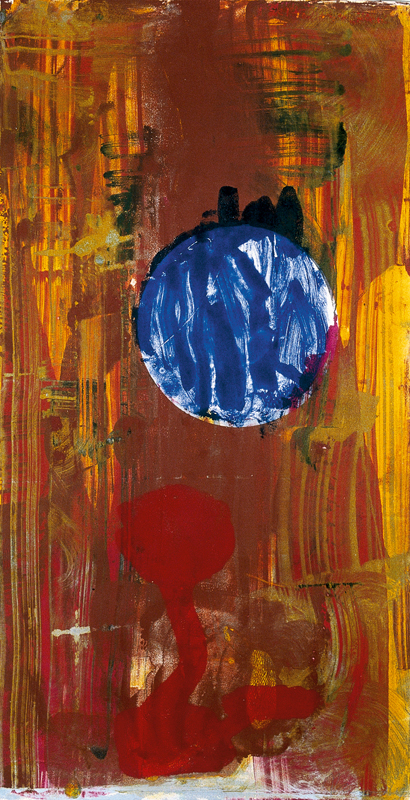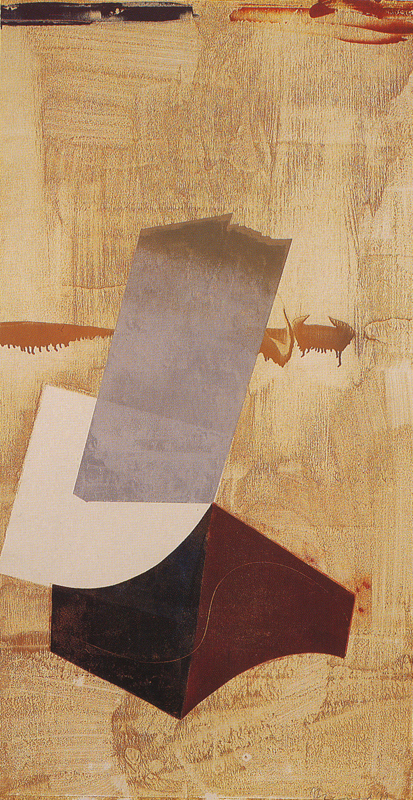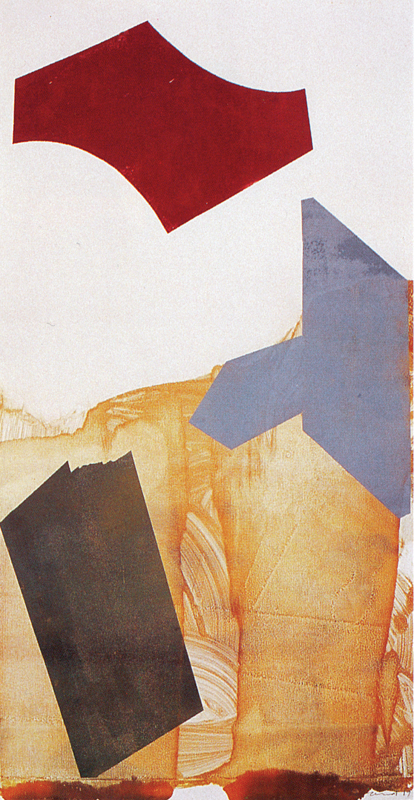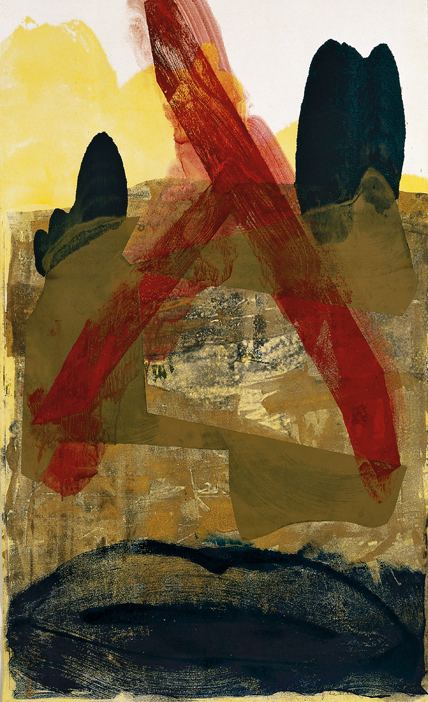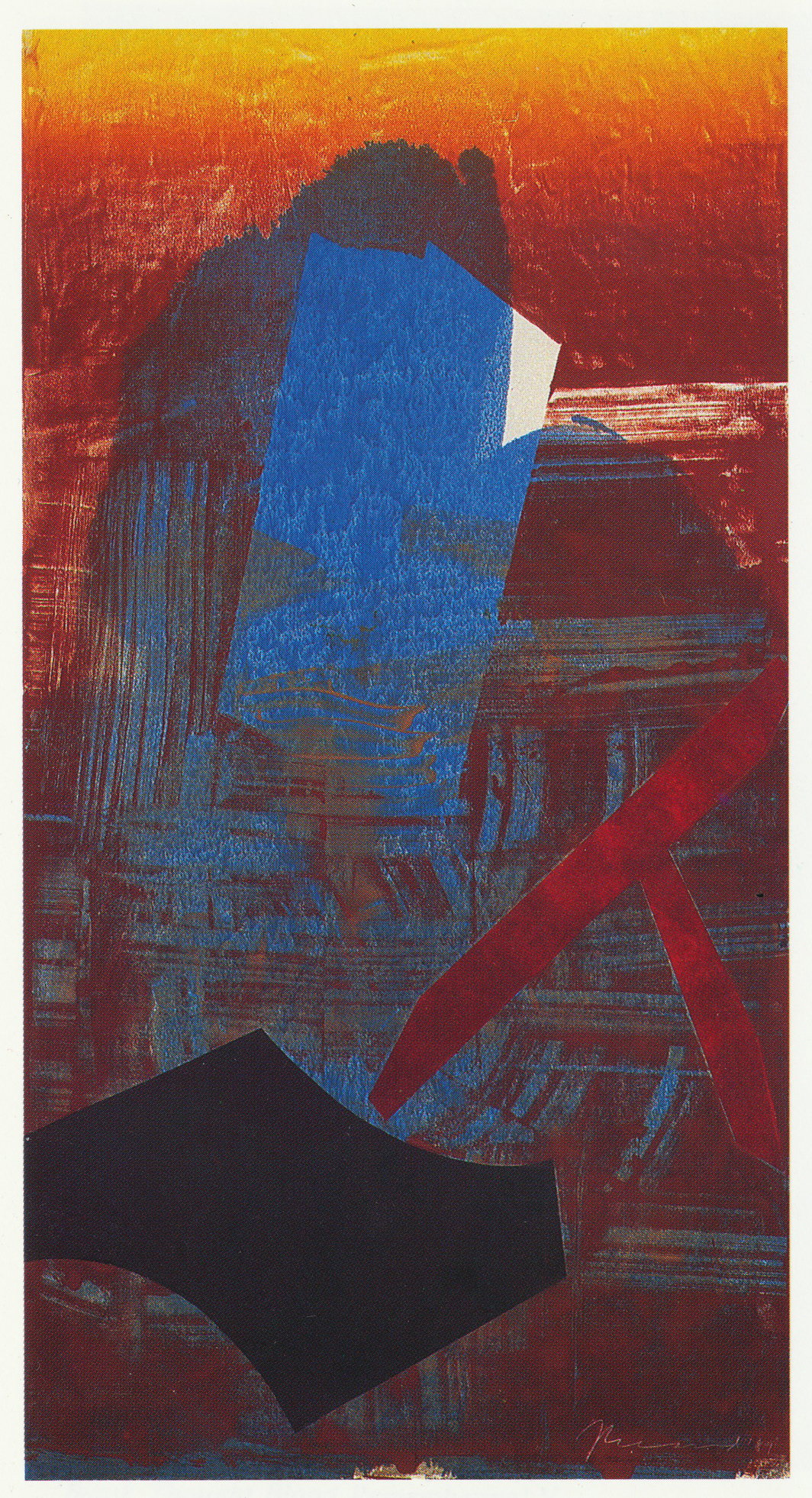LATE 1980'S
In the 1980s, the portrait format implies, first and foremost, a focus on centrality. The central form attracts our attention and indeed suggest, to a greater or less degree, the presence of a face or figure. But the painter’s job is not to clarify the perceptual issue of whether the centre will hold or not. It is, in effect, to complicate the very possibility of such a perception. Perhaps this is why the sequence of works involved in this process signals once again, in its range of titles, the indeterminacy that is certainly inherent in the painter’s approach. - S. BANN
Gimlet (1986) shows a layering process. The figurative element takes several forms – from the clumping bands of paint that look as if a figure has been completely bound within a vast length of scarf, through to a line drawing of a cartoonlike two-finger salute that looks as if it might be a remnant line rather than one positively applied. Either way this language of positive and negative within and without the figural seems to be everywhere in Beard’s imagery. - A. BOND
Head Painting (1987) certainly marks a milestone in Beard’s career, since he is arriving at a subject that will prove almost inexhaustible in the future. But this ‘Head’ is assembled out of a criss-cross linear patterning that deliberately refuses any degree of mass or solidity. - S. BANN
Faces appear out of the painterly process and retreat into the field. Head painting (1987) is particularly interesting as in hindsight we can see premonitions of the Adraga series that Beard was to spend years painting after 1992, and of the recent large-scale white-on-white and black-on- black portraits. ‘Now you see it, now you don’t’ seems to be a persistent theme in Beard’s painting from this time on, and indeed his personal presence in Australia became more and more sporadic from about this period. - A. BOND
Directly related in period and character to Head Painting, the two works entitled The Trial I (1987) and The Trial II (1988) appear once more to be exercises in the establishment of a central figurative focus that insists at the same time on the precariousness of that focus. Perhaps it is in that particular sense that they are ‘trials’. - S. BANN
Finally Mask (1987) appears to be, both in conceptual and in plastic terms, an acknowledgement of the impossibility of obtaining in any unproblematic way the certainty of a reciprocal image that will meet the subject’s gaze. This ‘mask’, if we locate it in the darker structure centred in the foreground, is no more than a simulacrum of a face. It is seemingly permeable, and floats in a deep, impalpable space. There is the sense of a courageous attempt to retrieve an iconography which has just slipped through the artist’s fingers. - S. BANN
Across the Bridge (1989) is a comparatively rare example of a work in the large landscape format, measuring 213 x 244 cm. In fact it explicitly foregrounds the bridge motif, which is conveyed through the curved line that connects the two sides of the composition. This is a device for anchoring a broad landscape that was used in the Western tradition at least as far back as Poussin. But in Beard’s case, it does not appear to be followed up by similar examples. On the contrary, it leads on to further experiments in the dynamic organisation of space that appear to have a more recent origin. - S. BANN
Tiger (1987) is one of the largest of the sequence at 248 x 203 cm. Still allied to the series of The Trial I and Thee Trial II, Mirror and Mask, it picks up in its title the tawny yellow tonalities that are distributed across the pictorial field. This is not a work that attempts to achieve the facing effect of its predecessors, but it nonetheless suggests a figurative motif that is hidden in the image. - S. BANN
Free Falling (1989) is a vigorously painted, downward rushing view that is reminiscent of Peter Lanyon’s dynamic Cornish landscapes, derived from aerial observation. All of these examples taken together imply a reluctance to abide with any particular formula for the treatment of space. In all of them, an equal importance is accorded to the choice of colours and the articulation of form through drawing. - S. BANN
An interesting change takes place, however, around 1989. One sign of this would be the distinctive series of monotypes which bears the title Blank Thought, Blood Remembering. These works employ flatter areas of colour, and less emphasis on drawing, as is appropriate for the new technique. The virtual elimination of any gestural signs creates a cooler, more cerebral atmosphere. But what most obviously distinguishes the compositions from the earlier paintings is the fact that their dimensions are 185 x 99 cm. This is neither a conventional landscape nor a portrait format. Indeed it is registered visually as a double cube. The creation of deep space within such a format is virtually impossible. Consequently the surface itself comes to appear much more significant. - S. BANN








